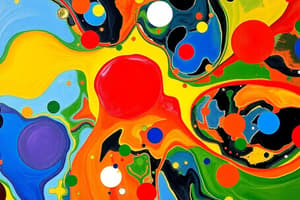Podcast
Questions and Answers
Which statement correctly describes trailing zeros in decimal notation?
Which statement correctly describes trailing zeros in decimal notation?
- Trailing zeros always round the number up.
- Trailing zeros after the decimal point are non-significant.
- Trailing zeros are only significant in whole numbers.
- Trailing zeros after the decimal point are significant. (correct)
Which of the following correctly demonstrates the conversion from decimal notation to scientific notation?
Which of the following correctly demonstrates the conversion from decimal notation to scientific notation?
- 0.0000156 = 1.56 x 10−5 (correct)
- 0.000120 = 1.2 x 10−3
- 0.000005 = 5 x 10−6
- 0.000034 = 3.4 x 10−5 (correct)
When performing multiplication involving significant figures, how is the final answer determined?
When performing multiplication involving significant figures, how is the final answer determined?
- It is based on the total number of digits in the result.
- It has the same number of significant figures as the number with the most significant figures.
- It includes all significant figures from the original numbers.
- It has the same number of significant figures as the number with the least significant figures. (correct)
What does the law of conservation of mass state?
What does the law of conservation of mass state?
What characterizes isotopes of an element?
What characterizes isotopes of an element?
Which state of matter has the weakest force of attraction among its particles?
Which state of matter has the weakest force of attraction among its particles?
Which of the following is an example of an extensive property of matter?
Which of the following is an example of an extensive property of matter?
What type of physical change occurs when dry ice sublimates?
What type of physical change occurs when dry ice sublimates?
Which method is used to separate a solid component from a liquid component?
Which method is used to separate a solid component from a liquid component?
What is a characteristic of homogeneous mixtures?
What is a characteristic of homogeneous mixtures?
Which of the following best describes percent error?
Which of the following best describes percent error?
Which of the following statements about significant figures is correct?
Which of the following statements about significant figures is correct?
Which property of matter is defined as the closeness of measured values to the target value?
Which property of matter is defined as the closeness of measured values to the target value?
Flashcards are hidden until you start studying
Study Notes
Matter and Its States
- Matter is characterized by having both mass and volume.
- States of matter include:
- Solid: Strongest force of attraction. Examples: tables, chairs.
- Liquid: Takes shape of the container. Examples: water, oil.
- Gas: Weakest force of attraction. Examples: smoke, air.
Properties of Matter
- Physical Properties: Include density, melting point, boiling point, and freezing point.
- Chemical Properties: Include oxidation state, flammability, and corrosiveness.
- Extensive Properties: Depend on the amount of substance. Examples: weight, volume, length.
- Intensive Properties: Depend on the substance's nature. Examples: luster, color.
Physical Changes of States
- Sublimation: Transition from solid to gas (e.g., dry ice).
- Evaporation: Liquid to gas change.
- Condensation: Gas transforming into a liquid.
- Freezing: Liquid becoming a solid.
- Melting: Solid turning into a liquid.
- Deposition: Gas changing directly to a solid.
Boiling Point
- Boiling point of water: 100° C (212° F, 373.15 Kelvin).
- Boiling point is classified as a physical intensive property.
Separation of Mixtures
- Distillation: Separates liquids with different boiling points.
- Evaporation: Removes a solid from a liquid.
- Filtration: Separates larger particles from smaller ones.
- Paper Chromatography: Components of mixtures separate based on differing travel rates on paper.
- Centrifugation: Used for diagnosing blood and urine samples.
Types of Mixtures
- Homogeneous Mixtures: Also known as solutions; have uniform composition. Examples: air, seawater, vinegar.
- Heterogeneous Mixtures: Not uniformly distributed. Examples: mixed nuts, salads.
Precision and Accuracy
- Precision: Consistency of repeated measurements.
- Accuracy: Closeness of a measured value to the true value.
- Positive Error: Measured values exceed expected values.
- Negative Error: Measured values fall below expected values.
- Percent Error: Indicates the accuracy of experimental values.
- Random Errors: Can be reduced by taking repeated measurements.
Significant Figures
- Non-zero digits are always significant.
- Zeros between non-zero digits are significant.
- Trailing zeros not following a decimal are not significant.
- Zeros to the right of a decimal point in numbers greater than one are significant.
- Significant figures in multiplication/division: result adheres to the measurement with the least significant figures.
Laws of Matter
- Law of Conservation of Mass: Atoms are neither created nor destroyed in chemical reactions; mass of reactants equals mass of products.
- The properties of an atom of one element differ from those of different elements.
Isotopes and Atomic Structure
- Isotopes: Same atomic number, different mass number.
- Atomic Number: The number of protons in an atom.
- Mass Number: Sum of protons and neutrons (mass number = protons + neutrons).
- Neutrons Calculation: Neutrons = mass number - protons.
Ions
- Cation: Positively charged ion.
- Anion: Negatively charged ion.
Chemical Formulas
- Molecular Formula: Indicates types and quantities of atoms in a molecule.
- Structural Formula: Represents atom arrangement through drawings.
- Empirical Formula: Shows the smallest whole number ratio of atoms present.
Studying That Suits You
Use AI to generate personalized quizzes and flashcards to suit your learning preferences.




